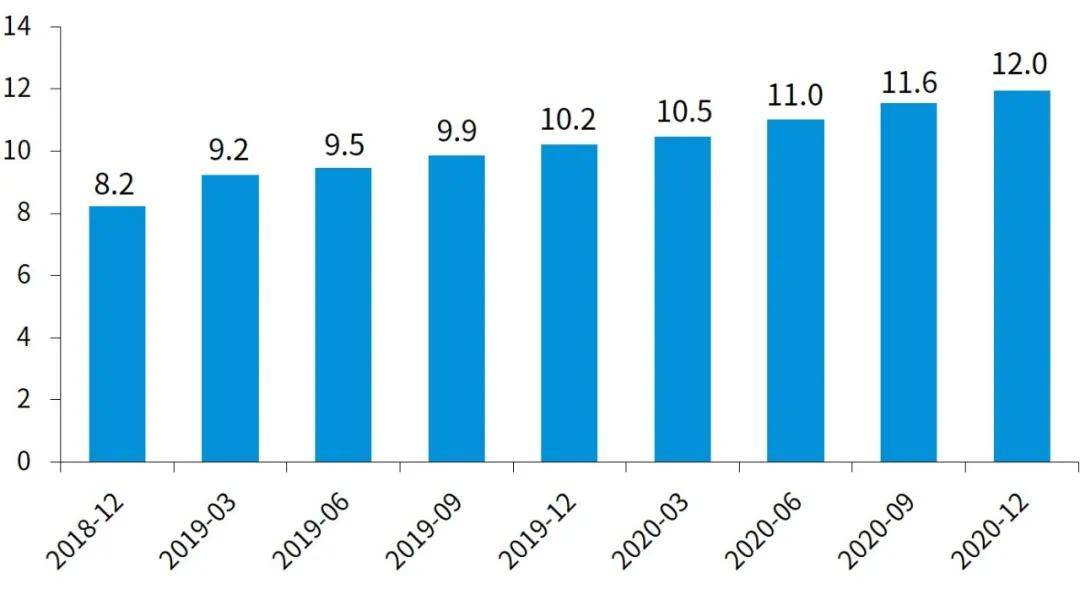✦This article is transferred from: China Business News, April 14, 2021
Author: Kang Yong, Lin Wei
Editor’s note
Media reports are the main channel for the public to learn about KPMG’s latest developments and exclusive opinions, and it is also a bridge between us and the public. We have specially opened “Media Collection” Column, I hope you can learn KPMG’s exclusive views on hot issues in the industry and society through this column.

The development environment faced by enterprises after the epidemic has become more complex and changeable. First, China’s economy is at a critical stage of transformation and upgrading, and it is not easy to increase its technological content and move towards the high-end areas of the value chain; second, the epidemic is still continuing around the world, the external environment is highly uncertain, and the simultaneous recovery of the world economy is still facing difficulties. Big challenge; finally, the development of science and technology is accelerating, and the emergence of emerging technologies brings new business models and competitors, and the competition faced by enterprises is becoming increasingly fierce. Faced with such an environment, how can companies stay ahead of the competition in the future? We believe that two transformations are essential for future corporate development: Intelligent Transformation and Green Transformation
Intelligent transformation
The outbreak of the new crown epidemic last year has brought rare development opportunities to technology companies. At the same time, for many companies, the epidemic is also a test of the effectiveness of their digital transformation. Companies with a high degree of digitalization have used the digital systems that have already been launched to fully guarantee production and management during the epidemic, and the speed of resuming work and production is also faster; while some companies that are relatively slow in digital transformation or rely more on offline business face Greater challenge. The epidemic has brought many impacts to human society, and the long-term effects of some impacts still need time to test. But a clear trend is that the epidemic has accelerated digital transformation.A KPMG survey of CEOs of major global companies showed that 80% of CEOs said that the epidemic has greatly accelerated the company’s digital transformation, and 30% of them said that the epidemic has accelerated the company’s digital transformation for several years.[1].
On the basis of digitalization, intelligent transformation is the only way for enterprise development. The development of information technology has gone through several stages from informatization-networking-digitalization-intelligence. With the rapid rise of artificial intelligence and more and more widespread applications, the development of enterprises will also enter the next stage from digitalization, that is, intelligent transformation. At present, many leading companies in the industry have evolved from early digitalization attempts to digitalization, which runs through all departments of the company, and has accumulated a large amount of data. On this basis, companies urgently need to use artificial intelligence and other technologies to better tap and utilize the value of data assets, facilitate product and service innovation, and discover new business and business models. Intelligent transformation is being used in many industries. For example, in wind power generation, 30% of the power generation may be wasted, and it is very important to accurately predict the power generation. Wind power companies use the Industrial Internet and artificial intelligence to improve the accuracy of power generation forecasts and significantly improve power generation efficiency. In addition, user insights based on AI algorithms are also being used in new retail, new manufacturing and other fields to help companies better understand consumer needs.
Intelligent transformation can not only help companies improve production and services, and discover new needs, it can also help improve their agile capabilities. The rapid changes in the market and the continuous updating of technology have made the competition faced by enterprises increasingly fierce, and the agile ability to respond to changes has become an indispensable core competency of enterprises. For example, in the era of internal combustion engines, traditional car companies usually require more than 4-5 years of research and development cycles to develop a model. However, the rise of new energy vehicles, especially the addition of some new car-making forces and technology companies, has greatly shortened the iteration of new energy vehicles, and put forward higher requirements for the development and launch of new models of car companies. Intelligent transformation has accelerated the evolution of the company’s R&D process from a “serial mode” to a “parallel mode”, and realized crossover, reorganization and optimization of the independent and sequential R&D work in the past, thus greatly shortening the R&D cycle and improving the company. The agility to respond to changes.
Green transformation
Green transformation is another key element for companies to cope with future challenges. It is worth noting that, compared with the attention of all walks of life to digital transformation, the current enterprises’ emphasis on green transformation needs to be improved. There are two main reasons why companies need green transformation. On the one hand, they are macro policy trends and continuously strengthened supervision; on the other hand, they also come from the development needs of the company’s own business.
At the policy level, green development is an important part of the five new development concepts of innovation, coordination, greenness, openness, and sharing in China’s 14th Five-Year Plan. The term “green” has appeared 50 times in the “14th Five-Year Plan”. Among the 8 binding indicators, 5 are related to the environment, which shows that the government attaches great importance to green development. China plans to achieve carbon peaks by 2030 and carbon neutrality by 2060. The proportion of non-fossil energy in primary energy consumption will reach about 25% by 2030, all of which have set clear requirements for green development. In recent years, central environmental inspections, special inspections, local inspections, etc., have become more stringent in terms of environmental protection law enforcement and the formulation of various measures. A large number of “scattered and polluting” enterprises have been shut down, and many enterprises have been suspended for rectification for reasons such as non-compliance with environmental protection standards and illegal discharge and over discharge. In the future, many companies, especially listed companies, may face mandatory environmental information disclosure requirements. Under constantly strengthened supervision, if companies do not pay enough attention to environmental and social issues in their operations, they will face increasing compliance risks.
At the enterprise level, green transformation can also create value for enterprises. ESG, that is, Environmental, Social, and Governance (Environmental, Social, and Governance) embodies the values of an enterprise, and the expression of an enterprise’s ability to develop its sustainable development has received increasing attention from all over the world in recent years.Many studies have found that there is a positive correlation between corporate ESG management and company performance. Companies with good ESG performance can usually achieve higher profits.[2]. At the same time, a good ESG helps companies improve employee engagement and customer loyalty, enhance corporate reputation, increase corporate competitive advantages, and generate long-term value. In addition, green enterprises and green projects are also easy to obtain more financing channels and lower financing costs.In recent years, my country’s green finance has developed rapidly. At the end of 2020, my country’s green loan balance will reach 12 trillion yuan (Figure 1), the largest stock in the world, and 813.2 billion yuan in stock of green bonds, ranking second in the world, providing financial support for green development[3].
Figure 1: China’s green loan balance, trillion yuan
 Data source: Wind, KPMG analysis
Data source: Wind, KPMG analysis
Compared with some leading foreign companies, Chinese companies started late in the green transformation.According to statistics from Haitong International, among 121 international financial institutions ranked in the Fortune Global 500 in 2020, 42 have announced carbon neutral plans, and 30 have achieved carbon neutrality, but none of them are currently Chinese financial institutions. mechanism[4]. Compared with these large companies, small and medium-sized enterprises are under greater pressure to achieve carbon emission targets due to capital and technology constraints, and they urgently need to think about strategies and implementation plans for green transformation.
How companies promote intelligent and green transformation
Intelligent and green transformations are undoubtedly crucial to the future development of enterprises, but it is not easy to promote these two transformations and cannot be accomplished overnight. The pain points and challenges faced by different companies and different industries are not the same, and the keys and paths to achieve these two transformations are bound to be different. In general, the following three items are something that companies need to consider carefully when promoting these two transformations.
01. Support from the top of the company
A common feature of intelligent and green transformation is that they may make adjustments to the company’s overall business model, decision-making model, and even organizational structure. These deep-level changes are obviously difficult to implement without the participation and support of the company’s top decision-making level. of. The company’s top leaders need to recognize the necessity and urgency of transformation, and as the highest promoter of transformation, formulate transformation goals from the perspective of corporate strategy, and promote related issues of resource allocation and coordination. The company’s board of directors may also consider setting up a special committee to take charge of these two transformations, and regularly check and evaluate the implementation and effects of the transformation plan.
02. Oriented by corporate value
Some companies tend to pay too much attention to the technology itself when promoting intelligent and green transformation, such as what AI technology to use, and what technological means to use to reduce carbon emissions, while ignoring that its fundamental purpose is to create long-term value for the company. Transformation requires companies to think about how to make changes in R&D, production, marketing, management, services, and ecology. Cross-departmental collaboration is essential. To this end, companies should take demand as the traction and improve corporate value as the goal, so as to promote effective cooperation between departments. In actual implementation, companies can also combine the effects of transformation promotion with performance rewards to guide incentive resources to tilt in the direction of transformation.
03. Develop a comprehensive and clear vision strategy, but it can be implemented in stages
In fact, not only at the enterprise level, but at the national level, my country’s promotion of carbon emission reduction is also carried out step by step, first achieving carbon peaks and then achieving carbon neutrality. Companies can also have a grand vision, and then, based on their own conditions and industry characteristics, formulate specific transformation plans in line with long-term strategies, and promote project development and implementation in stages and steps.
[1] KPMG’s 2020 Global CEO Survey: Covid-19 Special Edition, KPMG, 2020, https://home.kpmg/cn/zh/home/insights/2020/09/kpmg-2020-ceo-outlook-covid-19 -special-edition.html
[2] Foundations of ESG Investing: How ESG Affects Equity Valuation, Risk, and Performance, MSCI, July 2019
[3] “Text Record of Briefing on Green Finance of the State Council Information Office”, People’s Bank of China, February 9, 2021, http://www.pbc.gov.cn/goutongjiaoliu/113456/113469/4191657/index.html
[4] Paths and Methods for Chinese Financial Institutions to Achieve Carbon Neutrality, Haitong International, April 2021
The content of this article is for general reference only, and is not provided for any individual or specific situation of any individual or group. Although we have endeavoured to provide accurate and timely information, we cannot guarantee that the information will remain accurate when you receive it or in the future. No one should act in accordance with the content contained in it without carefully considering the relevant circumstances and obtaining appropriate professional advice. All the content provided in this article should not be considered as formal audit, accounting or legal advice.
©2021 KPMG Huazhen Certified Public Accountants (Special General Partnership), KPMG Consulting (China) Co., Ltd. and KPMG Certified Public Accountants are all associated with KPMG International Limited (“KPMG International”), a private UK company limited by guarantee. KPMG International does not provide any customer service. Each member firm is its own independent legal subject, and so is its description of itself. KPMG Huazhen Certified Public Accountants (Special General Partnership)-a Chinese partnership accounting firm; KPMG Consulting (China) Co., Ltd.-a Chinese limited liability company; KPMG Certified Public Accountants-a Hong Kong partnership firm. All Rights Reserved. KPMG’s name and logo are trademarks or registered trademarks of KPMG International.





























































You must log in to post a comment.